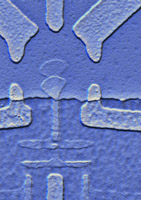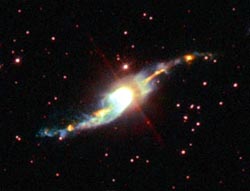Physics and Astronomy
This area deals with the fundamental laws and building blocks of nature and how they interact, the properties and the behavior of matter, and research into space and time and their structures.
innovations-report provides in-depth reports and articles on subjects such as astrophysics, laser technologies, nuclear, quantum, particle and solid-state physics, nanotechnologies, planetary research and findings (Mars, Venus) and developments related to the Hubble Telescope.

Chandra provides new view of biggest construction sites in universe
Images made by NASA’s Chandra X-ray Observatory have revealed two distant cosmic construction sites buzzing with activity. This discovery shows how super massive black holes control the growth of massive galaxies in the distant universe.
X-rays were detected from vast clouds of high-energy particles around the galaxies 3C294 and 4C41.17, which are 10 and 12 billion light years from Earth, respectively. The energetic particles were left over from past explosive events that can be traced

Physicists measure individual electrons in real time
Ultracold experiment opens door for basic studies in quantum computing
Physicists at Rice University have completed the first real-time measurement of individual electrons, creating an experimental method that for the first time allows scientists to probe the dynamic interactions between the smallest atomic particles.
The research, which appears in the May 22 issue of the journal Nature, is important for researchers developing quantum computers, a revolutionary type of compu

The mysterious ’Garden-sprinkler’ nebula
There are many mysterious objects seen in the night sky which are not really well understood. For example, astronomers are puzzled by the “jets” emerging from planetary nebulae. However, the S-shaped jet from Henize 3-1475 is the most perplexing of all.
“Jets” are long outflows of fast-moving gas found near many objects in the Universe, such as around young stars, or coming from black holes, neutron stars, and planetary nebulae, for example. The NASA/ESA Hubble Space Telescope has imaged th

Five Spacecraft Join to Solve an Auroral Puzzle
Five spacecraft have made a remarkable set of observations, leading to a breakthrough in understanding the origin of a peculiar and puzzling type of aurora. Seen as bright spots in Earth’s atmosphere and called “dayside proton auroral spots,” they are now known to occur when fractures appear in the Earth’s magnetic field, allowing particles emitted from the Sun to pass through and collide with molecules in our atmosphere. On March 18, 2002, a jet of energetic solar protons collided
Brighter Neptune suggests a planetary change of seasons
A progressive increase in the brightness of the planet Neptune suggests that, like Earth, the distant planet has seasons.
Observations of Neptune made during a six-year period with NASA’s Hubble Space Telescope by a group of scientists from the University of Wisconsin-Madison and NASA’s Jet Propulsion Laboratory (JPL) show that the planet is exhibiting a significant increase in brightness. The changes, observed mostly in the planet’s southern hemisphere, show a distinc

Origin Of New Moons Explained
The ability to understand how small bodies such as moons switch from orbiting the Sun to orbiting a planet has long remained one of the outstanding problems of planetary science. A paper published in Nature on 15 May shows how this problem has been resolved using chaos theory, enabling scientists to predict where astronomers might search for new moons orbiting the giant planets.
In the last couple of years many small moons have been found orbiting the giant planets in our Solar System. For e